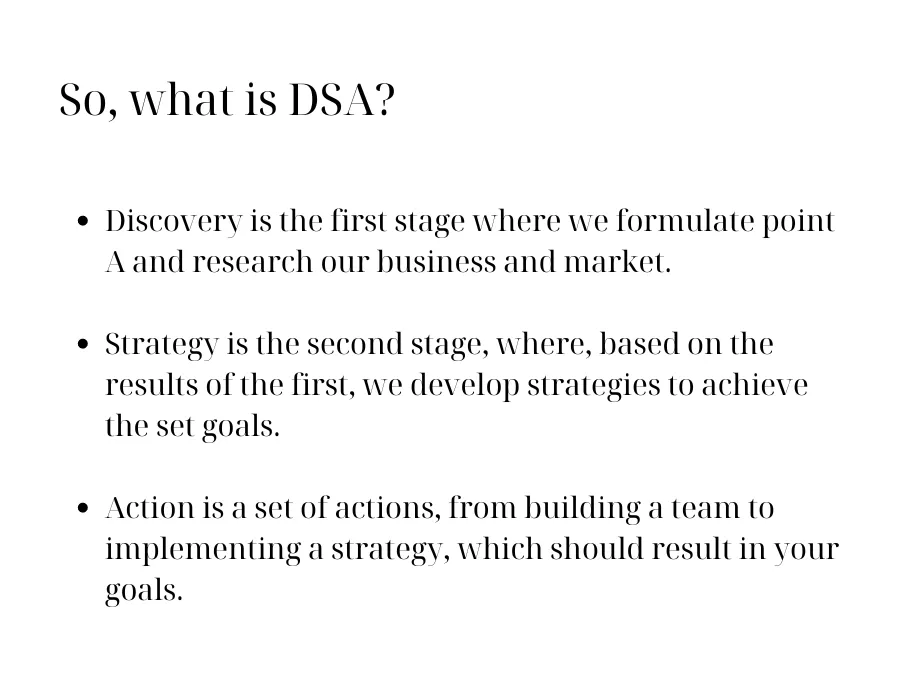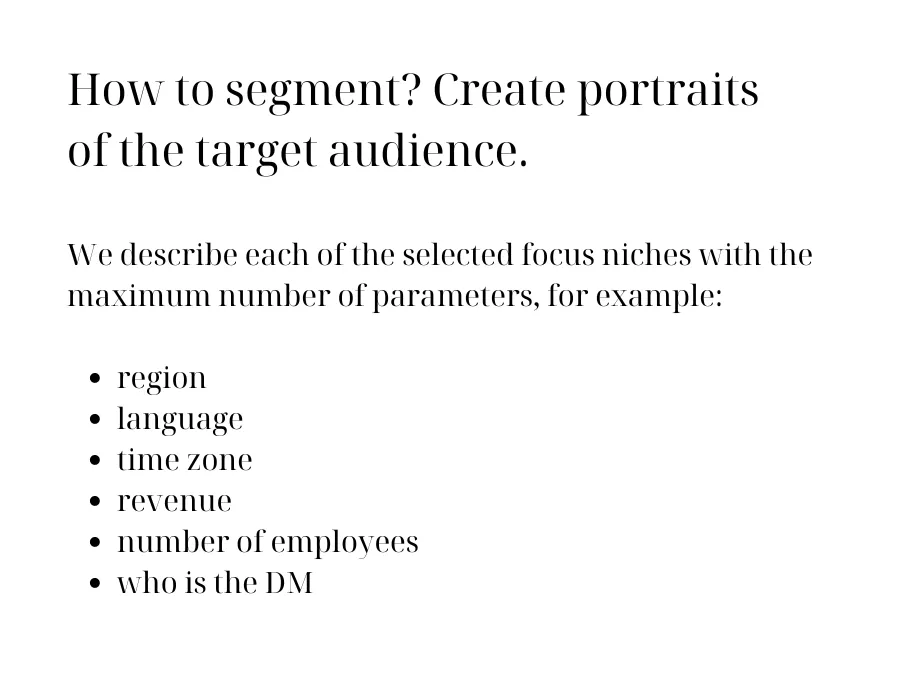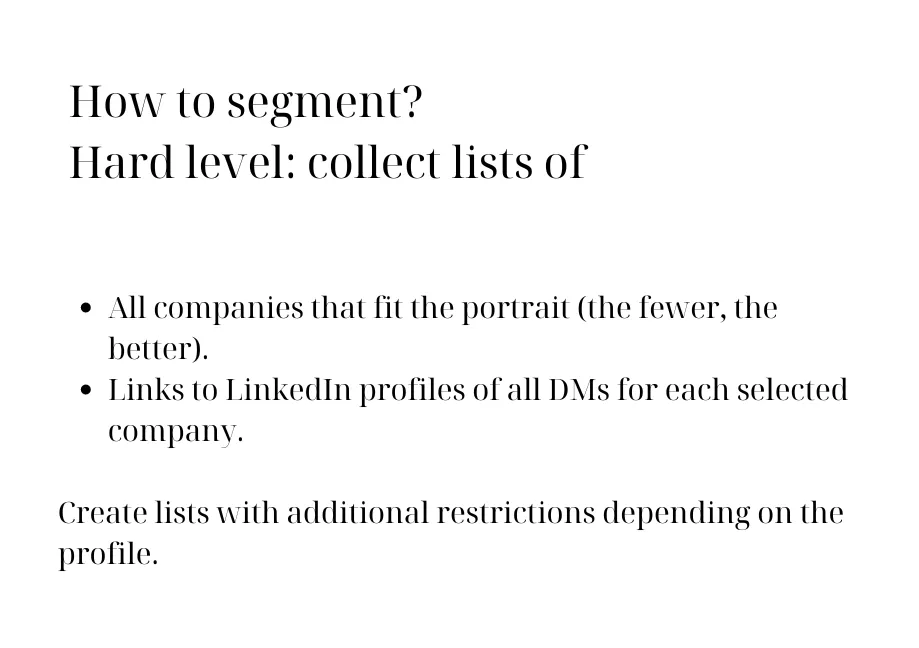Your Marketing Isn’t Working? Here’s How to Research Using DSA
Imagine the situation: you have set marketing goals, the marketing plans are put into motion, and everyone is actively working. Time passes, but you are as far away from the expected profit as the moon. How do you know if your expectations were too high or if your marketing team is failing? What exactly have you overlooked?
In this article, I will explain what the DSA framework is and what it is based on, with a focus on the discovery stage. I’ll also discuss why it’s important to conduct business research and how it can help you improve your marketing and get the results you want.
What is DSA (Discovery, Strategy, Action)?
In my work, I like to find patterns that will help me build systems for improvement. For several years now, I’ve been observing and analyzing how marketing works in the B2B companies I’ve been providing consulting services to, among both clients and our own companies in the Netpeak Group.
Based on my observations, I created a framework called DSA — a logical and simple system with no magic.
So what is the idea behind it? Before you start spending money on active marketing activities, you need a plan. To do this, you need to determine point A, i.e., where exactly the business is at the time of planning.
First, you need to research what is happening in and around the business, develop a detailed action plan, choose tools, and build a team. Only then can you act to spend money and win new customers.
The framework consists of three broad, sequential stages:
- D (Discovery). The research stage, where I create a point A and investigate the business and the market. This is actually my favorite phase, as you learn a lot about the new business, the competitive market, and internal and external processes. It usually takes four to six weeks, depending on the size of the business, the market, and the ambition of the goals.
- S (Strategy). The next stage is strategy development. Based on the results of the first stage, it is necessary to develop a strategy to achieve the goals. Each strategy takes up to two months to develop.
- A (Action). When the research is done and the strategies are developed, it is time to take action that will produce the desired results. The positive outcome of this stage will be achieving the KPIs set out in your strategies. It’s the longest stage and can last six to twelve months or more.
Each major stage is broken down into sub-stages. For example, the discovery stage consists of three smaller steps: briefing, audits (internal and external), and presenting the results.
For the final step, you can brief either a representative of the client company or yourself and present to the board of directors. If you are a founder, you can present to the team or top management.
How to do a briefing?
The purpose of a briefing is to understand and digitize the company’s main business goal. For example, a company may want to generate revenue in a certain period of time.
The other task at the briefing stage is to establish a starting point, i.e., point A. This will help you understand:
- What was done before, and what were the results?
- What has never been done?
- What was done wrong or ineffectively?
Then, the only thing left to do is to connect the company’s main business goal, i.e., point B to point A, with a straight line that reflects your plan. Spoiler alert: in reality, this line will never be straight :)
Important questions to ask during your research
- Who is the customer (ICP and buying persona)?
The ІCP (ideal customer profile) is a portrait of the business’s customer, and the buying persona is a portrait of the person who makes the decision to work with you.
For example, if you have an online home appliance store in a B2C segment, your customer could be a person who decides to buy a clothes iron. If you work in B2B, there is a client company, and there is a person or several people who influence or make the decision to cooperate.
You have to figure out who your customer is. About 80% of the companies I’ve worked with don’t have an answer to that question.
- Where are your customers coming from (location and channels)?
Find out where your customers are coming from, in terms of their geographical location (countries and cities) and digital channels, such as organic, paid, and referral traffic.
- What is the sales funnel?
The sales funnel refers to the stages that a customer goes through until he or she brings money to the company. It includes everything from the moment of registration, ordering or sending an order to the moment of payment, to when you ship the goods or provide the services.
- What percentage of customers come from marketing channels?
Most of the time, not 100% of the conversions come from marketing channels.
For example, if a founder with a great personal brand has profiles on Facebook or LinkedIn, some of the company’s customers could come through them. People may write personal messages to the founder, and they would pass those customers on to the sales force. Typically, the affiliate channel is not considered a marketing channel either.
It is necessary to understand that if a company aims to make a million dollars in revenue in a year, but the percentage of marketing clients is 70%, the marketing goal will not be 100%. It will be only 70%. At the same time, it is important to consider the possibility of scaling other channels, such as the sponsor’s brand, the affiliate channel, etc.
- How to calculate the marketing budget?
Think of a budget as an investment: you have $500,000 a year, and you’re willing to invest it in marketing to make $1,000,000. You can also calculate the budget amount as a percentage of revenue or net profit.
A common mistake. When a founder decides to earn a certain amount, say $1,000,000 per year, they may think that it is enough to simply increase the marketing budget.
In fact, what is needed here is high-quality unit economics, i.e., revenues and expenses per customer or unit of goods, which is a unit for the entire life of the customer. Hiring salespeople and other specialists, which requires recruiting, onboarding, salaries, etc.
Otherwise, without scaling the business, the additional leads brought in by marketing will be wasted.
- What is the main goal for the following year, and how is it set?
Whether it is reaching $1,000,000 in sales, doubling last year’s number, or growing with the market, you need to understand the mechanics of setting your goal. If a million is the funder’s decision, you can work with that as well.
Primary access needed for the briefing
- Google Analytics (or other analytics system) to evaluate traffic and channels.
- CRM (or a customer database with all the necessary information about them) to review and cooperate with your customers.
Analytics shows where customers come from and conversion rates on the site. CRM shows what happens to customers after they apply and how quickly they are contacted. It also shows conversions, how customers move through the stages of the funnel, and what happens to them next.
How to conduct an audit
Once you have point A, where you are now (traffic, conversions, customers, and money), and point B (the goal for the year), the crucial stage of research and hypothesis begins.
Internal audit
In an online-first business, where one of the main tools for attracting customers or sales is a website, you should start your internal audit by building a funnel. That is, what happens to customers before they get to the site (points of interaction) and what happens after they click the “order” button until the end of the customer’s lifetime (the customer lifecycle).
Traffic sources:
- Organic. Traffic from search engines. SEO is responsible for this.
- Referral. Traffic from links on other websites.
- PPC. Paid traffic, e.g. contextual advertising, targeting.
- Direct traffic.
Additionally, conducting a thorough Google Analytics 4 Audit ensures your conversions and user behavior data are accurate and actionable.
The stages of the post-order funnel are typically divided into:
- MQL (Marketing Qualified Lead) — an application.
- SQL (Sales Qualified Lead) — a lead ready to buy.
- Customer — a customer or a conversion.
After collecting this internal data, you can add budgets and salaries and calculate two more useful indicators by month, quarter, or year:
- CPL (cost per lead). The price of a lead or an order.
- CAC (customer acquisition cost). The price of a customer acquired who made a purchase.
And then, do a cohort analysis. In my experience, some businesses tend to count conversions by the months in which they occurred. This is not good.
Important: In marketing, conversions should be counted in cohorts. Finance may not agree, but for marketing, it’s the right thing to do. Counting in cohorts makes it easy to see where the problems are and what exactly is not working or working poorly.
For example, let’s say the marketing department launched a campaign on Google Ads or published an article and drove traffic to the website in January. You received an order in January, communicated with the customer, and the purchase took place in March. That customer and conversion should be counted in January, not March.
Read the blog to learn how cohort research in Google Analytics 4 can help you retain customers more effectively.
Case study: One of my clients spent six months on Google Ads, but their number of SQLs was zero. When you see this, the first thing to do is stop spending money on PPC and do a separate audit of that channel. After the internal audit, you are ready for the next step.
External audit
Everything in this audit is based on the ideal customer. Do the audit, and if you already have several of the ICPs described, you’d better update the data as well.
To do this, segment your customers and choose your target niches. I recommend working in Google spreadsheets and specifying:
- The name of the customer company.
- The niche in which the customer operates.
- Whether it is possible to publish cases of collaboration (signed NDA or not).
- Whether there is a published customer case study.
- Whether there is text or video feedback from the customer.
Group the information by niche, summarize the number of customers, case studies, and reviews for each customer, and sort from largest to smallest. At the top of the table, you’ll see the niches with the highest number of customers, case studies, and reviews. These are the niches where it is easiest to get a new customer using ICP; here, you have deep expertise and a portfolio.
My advice is to choose three niches to focus on, create portraits, and describe them using as many parameters as possible. Here is an example of basic parameters:
Where the DM is a decision maker
If you want to go even further, create lists of all the companies that fit your customer’s profile. Fewer companies are better because it means a more accurate portrait. Include links to the prospect’s LinkedIn profiles.
For example, let’s say you have a mobile application outsourcing company:
- The first group will include companies that do not have a mobile application.
- The second will be companies with an application that has not been updated in a long time.
- The third will be companies with a clumsy design.
- The fourth will include companies with a user-friendly design and a recently updated app.
From this list, choose the companies that will be easier for you to work with.
The next level of complexity is to detail the information in this niche and conduct a survey among three groups:
- Your customers.
- Representatives of companies whose bids you have lost.
- PRs from target companies you have never met.
What to ask:
- How and when do you make a decision to cooperate?
- What influences your decision?
- Even if only 5% respond, you will still get a lot of ideas from this material on how to improve the website to attract leads and what to change in processes and marketing activities.
Thanks to ICP, you can evaluate the market and choose your competitors.
Competitor research
- Make a list of your competitors.
You don’t need a list of 1000 companies, just choose from your ICP.
On that note, if you have several ICPs and you see that a niche is overcrowded, this may be a sign to choose another one.
- Segment them.
Divide them into three groups:
- Those who are similar to you now (point A).
- Those you want to be like in a year (point B).
- Industry leaders.
- Do some research.
The following indicators are important:
- Traffic distribution in Similarweb.
- Link profile in Serpstat.
- What they do in context in adstransparency.google.com.
- Social networks and publications.
- Search results for brand queries.
- Website.
- Perform analysis.
Adopt a holistic approach:
- Create a spreadsheet that includes all data.
- Take screenshots where necessary.
- Copy the text of the examples in parts.
- Make comments based on two parameters, “the vast majority have it” and “really liked it”.
- Pay special attention to services, website structure, application form, etc.
Case study: Researching competitors and studying successful strategies is a good thing. But copying other people’s work should be done wisely.
Let me give you an example: a company decided to copy the Netpeak website, changing only the photos of people and the name. This had negative consequences as we talked about the situation on social media and notified the provider. The dishonest company was banned.
Once you’ve carefully collected your data, it’s time to package it.
To take your app strategy to the next level, check out our Mobile App Market Research Services. We help you discover real user behavior, competitive positioning, and feature demand — ensuring your digital campaigns hit the right notes from the start.
How to present your plans
At this point, you should have:
- Data and KPIs for the present moment (your point A).
- Goals and KPIs that the company wants to achieve in a year (point B).
- Ideas, hypotheses, and specific tasks that have emerged from customer responses, analysis of the SDI, and the competition.
Now, develop three plans with monthly KPIs for the year:
- The minimum plan is based on the initial budget from the brief.
- The maximum plan is based on the initial goals from the brief.
- The medium plan considers the first and second plans and is as close to the goals as possible, given the company’s budget and capabilities.
Now, gather the top management and present these three plans to them.
You will definitely need the founder if they are involved in the company’s affairs, as well as a CEO (Chief Executive Officer) if the founder is not performing their duties. You will need a CFO (Chief Financial Officer) or another person who knows the business, wants to develop it, and will fit all your ideas into the budget.
HR personnel should be welcome at the meeting, but the CEO and finance are the main participants.
The outcomes of the presentation should include:
- Approval of the hypotheses invented during the discovery stage.
- Approval of the business goals, plan, and budget.
- Approval of the roadmap.
- Synchronization of marketing expectations for the year.
Each participant in such a meeting should be confident that everyone has agreed on the work format, budget, and goals for the next year. And you clearly understand the critical areas of work where expertise is needed.
Next, you begin to engage specialists (external or internal) and develop the necessary strategies, but that is the subject of another article. For now, the Discovery stage is complete.
Conclusions
The DSA framework is a strategy I created for B2B companies to produce effective marketing plans.
D (Discovery) is for the discovery stage, S (Strategy) is for strategy development, and A (Action) is for actions to achieve the planned results. The discovery stage (D), which was the main focus of this article, consists of creating a briefing, performing internal and external audits, and presenting the results.
The purpose of the briefing is to digitize the company’s main goal and identify where the company is now (point A) in relation to the goal (point B).
During the briefing, you will aim to answer the following questions.
- Who is your customer (ICP and buying persona)?
- Where do the customers come from (geographical locations and channels)?
- What does the sales funnel look like?
- What percentage of customers are coming from marketing channels?
- What is the marketing budget, and how is it calculated?
- What is the next year’s main goal, and how is it formed?
For research at this stage, you will need access to Google Analytics and CRM. During the internal audit, take into account the traffic sources. Build a funnel and analyze the data on it, including MQL, SQL, and customer data.
I also recommend paying attention to useful indicators such as CPL and CAC. For internal audits, you need several detailed Ideal Customer Profiles, and the data must be current. If you don’t have an ICP, create one by segmenting your customers and choosing your target niches. With the help of the ICP, you will be able to evaluate the market and select competitors.
Once you have identified your competitors, here’s how to research them:
- Gather a list of competitors.
- Segment them.
- Study the competitors.
- Analyze the results.
To present the findings of the discovery stage, develop three plans with monthly KPIs for the year: a minimum plan based on the budget, a maximum plan based on the goals, and a medium plan that considers both budget and goals.
The presentation should lead to these outcomes:
- Confirmation of the hypotheses generated during the discovery stage.
- Agreement on business goals, plan, budget.
- Approval of the roadmap.
- Synchronized marketing expectations for the year.
Related Articles
How to Set Up Consent Mode in GA4 on Your Website with Google Tag Manager
Let's explore how to properly integrate consent mode in GA4, configure it for effective data collection, and at the same time comply with GDPR and other legal regulations
Display Advertising Effectiveness Analysis: A Comprehensive Approach to Measuring Its Impact
In this article, I will explain why you shouldn’t underestimate display advertising and how to analyze its impact using Google Analytics 4
Generative Engine Optimization: What Businesses Get From Ranking in SearchGPT
Companies that master SearchGPT SEO and generative engine optimization will capture high-intent traffic from users seeking direct, authoritative answers






